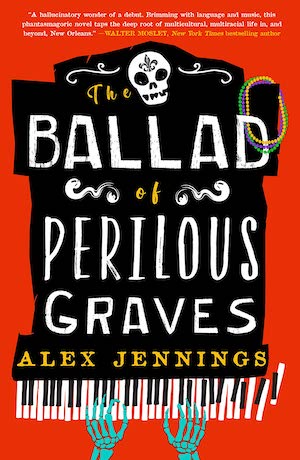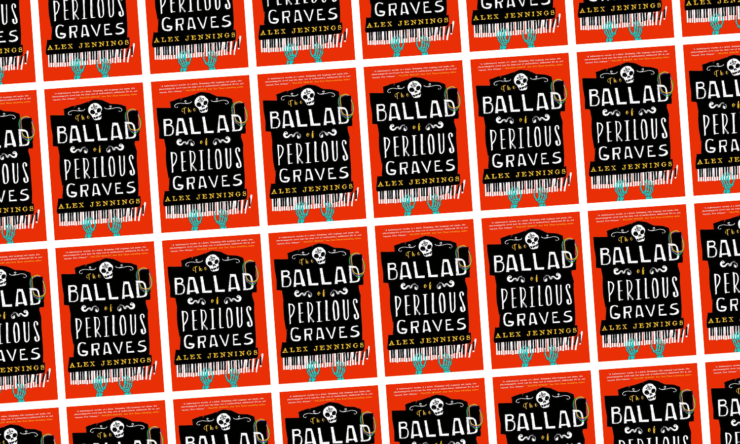There’s a point midway through Alex Jennings’ novel The Ballad of Perilous Graves in which Casey, an illustrator who is one of the novel’s central characters, looks at a sketch of a comic book character. In this case, it’s the magnificently-named supervillain Doctor Bong (so named because he wore a helmet in the shape of a bell), who was created by Steve Gerber and Marie Severin and debuted in the 1970s run of the Marvel comic Howard the Duck.
Casey observes that his take on the character is “more monstrous,” and goes on to describe it in greater detail: “More like something Richard Case would have designed for Grant Morrison’s run on Doom Patrol, but with the suggestion of Mignola’s deep shadows.” In one passage, Jennings has invoked a trio of iconic runs on various comics—encompassing the satirical verve of Howard the Duck, the surreal heroics of Doom Patrol, and the wide-ranging riffs on mythology and folklore found in Mike Mingola’s comics, especially Hellboy. And it may not come as much of a surprise to learn that many of those same descriptions apply to Jennings’s own novel.
The Ballad of Perilous Graves is a novel that slowly establishes what’s going on. Certain things that seem like unexpected shifts from one setting to another turn out to be jarring for a reason; other background details wind up having a substantial payoff later in the book.
Though the “Perilous Graves” in the title refers to one of the book’s central characters, that’s his full name, and throughout the book he goes by the more informal “Perry.” Perry—who recently finished the fifth grade—resides in Nola, which has numerous similarities to New Orleans, but also has a few things that it lacks. Flying trolleys, for one thing; also, a musician named Doctor Professor, who periodically emerges on the scene and prompts musical revelry.
“A line of cars waited patiently at Carondelet Street, their doors open, their drivers dancing on the hoods and on the roofs. It was just what you did when Doctor Professor appeared, whatever time of day or night.”
Eventually, Doctor Professor tasks Perry and his friends with retrieving the personifications of songs that keep the city functioning. Interspersed with this narrative is one set in New Orleans, following Casey as he settles in to life and work there, where he reconnects with his cousin Jaylon. Soon enough, he’s becoming enmeshed in the artistic life of the city, whether it’s taking in a band equally capable of playing transcendental versions of songs by Dr. John and Deerhunter or observing a bizarre phenomenon of graffiti hovering in midair.
Buy the Book


Tha Ballad of Perilous Graves
The two plotlines orbit one another in disconcerting ways. Percy’s narrative involves a more fantastical city, while Casey’s is more realistic—but there end up being moments where they coincide: a name that shows up in both, or an image that echoes across settings in a surprising manner. At a certain point in the novel, you might find yourself wondering about the nature of the relationship between Nola and New Orleans. Are they the same city seen from different angles, a la The City and the City’s Besźel and Ul Qoma? Or are we more in the realm of, say, Diane Duane’s So You Want to Be A Wizard—a formative book for me—which featured both New York City and a magical counterpart to it?
Exactly how these cities are connected does turn out to be one of the mysteries this novel interacts with. But it’s far from the only one; New Orleans’ fraught connection to various storms, including Hurricane Katrina, looms over the narrative as well. Jennings also throws in references to music and comics that span decades and styles, evoking everything from New Orleans’ musical icons to Al Ewing’s run as writer of Ultimates. And that’s without even getting into Percy’s friend Peaches Lavelle, capable of superhuman feats and abounding with stories of a long-lost father and confidence in all of the things she’s capable of.
There’s a point a little over halfway through the novel when Casey goes in search of answers from a powerful figure who helped create some of the mysteries central to the book’s plot. Except that at the point in the narrative when the all-knowing authority figure would usually explain the plot, this novel’s closest counterpart to that only acknowledges his limitations. “Son, you already capable of some shit I ain’t never seen in my long-ass life,” he says.
It’s a terrific moment, one that helps to demonstrate where Jennings is taking the narrative. There are aspects of the traditional hero’s journey to be found within The Ballad of Perilous Graves, but just like the band that so impresses Casey, they’ve been transformed in this rendition. Does this book sprawl? Most definitely, and occasionally to a dizzying extent. But in the same way a great piece of music leads you to a place you didn’t know you needed to go, this novel arrives at its destination with empathy and verve.
The Ballad of Perilous Graves is published by Redhook.
 Tobias Carroll is the managing editor of Vol.1 Brooklyn. He is the author of the short story collection Transitory (Civil Coping Mechanisms) and the novel Reel (Rare Bird Books).
Tobias Carroll is the managing editor of Vol.1 Brooklyn. He is the author of the short story collection Transitory (Civil Coping Mechanisms) and the novel Reel (Rare Bird Books).










